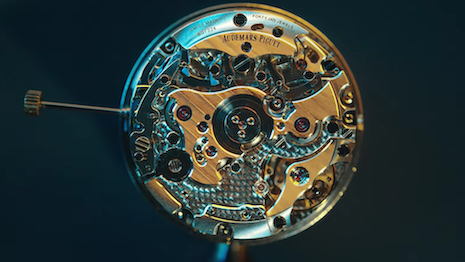 The Calibre 4401 is an evolution of Audemars Piguet's iconic Royal Oak. Image credit: Audemars Piguet
The Calibre 4401 is an evolution of Audemars Piguet's iconic Royal Oak. Image credit: Audemars Piguet
Swiss watchmaker Audemars Piguet is harnessing the power of patience, revealing the amount of time, meticulous processes and details that are put into creating its notable complications and designs.
Since 1875, the watchmaker has blended its propensity for innovation with the traditional craftsmanship of its founders. To honor this longtime vision, Audemars Piguet has released a series of short films showcasing the intricate details of its pieces, from self-winding movements to dial designs.
Time for the extraordinary
The first episode of the “It Takes Time to Create the Extraordinary” series is focused primarily on the development of the Calibre 7121 — a process five years in the making.
The timepiece is Audemars Piguet’s new extra-thin self-winding movement fitted for the “jumbo” case.
In a dramatic fashion, the film shows shots of sketches on walls and watchmakers illustrating various movements while unveiling exact numbers and measurements. The Calibre 7121 required 5,705 hours of research and development, 815 circular grains of the plate and 155 steps in its assembly.
Episode one details the making of the Calibre 7121
The second episode features a derivative of Audemars Piguet’s Calibre 7121 — the new Calibre 7124 extra-thin open-worked. This complication required manual agility to mend precision, performance, traditional open working savoir-faire and extra-thinness.
The Calibre 7124 required 15 hand-beveled styles, six gear bridge decorations and 268 total calibre components.
Close-up shots of the complication reveal just how detailed the piece is, and, ultimately, the precision and near perfection that is required of luxury watchmakers.
Mechanics meet hand-crafted design for the Calibre 7124
In the third installment, Audemars Piguet aims to showcase the convergence of chronometry and refinement by spotlighting its self-winding Chronograph Calibre 4401, an evolution of its iconic Royal Oak.
The Calibre 4401 features unique finishings, including Côtes de Genève, satin brushing, circular graining, circular satin and polished bevels.
Research and development for the piece’s case took 500 hours while the chronograph assembly required 16 steps. The frequency of its balance wheel is 28,800 vibrations per hour.
The science of time is at the heart of the third episode
Over many years, Audemars Piguet says it has worked to foster generations of craftspeople who continue to develop new skills and techniques, broadening their abilities to bring innovation to the industry — a key element of high watchmaking, like fashion or automotive.
In the details
With such a high standard for artisanship present in the watchmaking sector, it is no surprise that brands like Audemars Piguet want to bring customers inside their world.
At the end of last year, Audemars Piguet showcased how its elite watchmakers and engineers have mastered horology and technology through film.
“A Watch is Born” follows the creation of the house’s newest chronograph complication. The campaign relied on dramatic visuals to exemplify how Audemars Piguet relies on both craftsmanship and innovation (see story).
This March, the watchmaker launched an extensive, dedicated site cataloging the history of its iconic Royal Oak. Coinciding with the 50th anniversary of the timepiece, the new AP Chronicles site presents years of research and is meant as a reference source on the history of the Royal Oak.
The content touches on both the historic context, such as fashion, economics and the history of Swiss watchmaking, as well as the history of the watchmaker, manufacturing methods and production (see story).